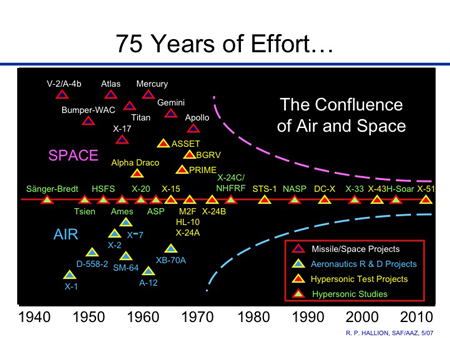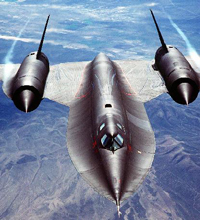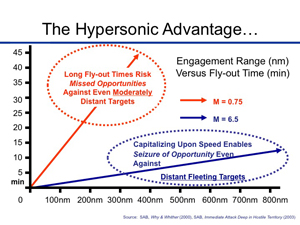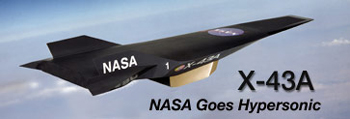Mark J. Lewis is chairman of Clark School’s Department of Aerospace Engineering at the University of Maryland, College Park, and president-elect of the American Institute of Aeronautics and Astronautics. He was the chief scientist of the U.S. Air Force from 2004 to 2008.
An earlier version appeared in the January 18th, 2010 issue of Space News.
***

Five Decades of Research
When NASA’s X-43 flight test vehicle separated from its Pegasus rocket booster and accelerated to high-Mach speeds powered by an air-breathing scramjet, the premise and promise of hypersonic flight were forever validated. With a first Mach-7 flight in March 2004, followed by a Mach-10 flight in November 2004, the hydrogen-burning X-43 vehicles were the culmination of nearly five decades of research in hypersonic air-breathing flight.
Next month, if all goes well, the next chapter in hypersonics will be written, as the U.S. Air Force’s X-51 vehicles begin their own series of flight tests.
In many ways, the X-51 is a perfectly logical follow-on to the X-43. Whereas the X-43 was fueled with hydrogen, the X-51 uses the somewhat more practical, though less energetic, hydrocarbon Jet Propellant-7 – the same fuel that powers the SR-71 Blackbird reconnaissance aircraft. Unlike its hydrogen-powered cousin, the X-51 has an engine that is actively cooled, meaning that it can fly under power for minutes, not seconds. And while the 12-foot X-43 was a sub-scale version of a future airplane, the X-51 is a missile-type configuration that could directly evolve into a useful hypersonic weapon.
The story of the X-43 could fill an entire volume; in fact, just such a book has been written, though it only tells a piece of the X-43 saga: The Road to Mach 10: Lessons Learned from the X-43a Flight Research Program (Library of Flight Series) by Curtis Peebles. In a nutshell, the X-43 was a flight vehicle that was derived as a scaled-down version of a concept for a global hypersonic cruiser. It was an incredible experiment in that it incorporated the first real flight of a so-called supersonic combustion ramjet, or scramjet, that produced net positive thrust.
The X-43 was launched from under the wing of a B-52 bomber, on the first stage of a Pegasus solid-fuel rocket. It was powered by hydrogen because that’s the fuel required to fly at Mach-10, the original design point of the vision vehicle; with a solid rocket to get it up to speed, the X-43 engine only had to operate in the hypersonic regime, it did not have to land or take off. In that sense, even though the X-43 was derived from an airplane concept, it was more closely analogous to a weapons application.
Credit Photo: www.NASA.gov
There were also some important lessons learned with the X-43, with implications to future hypersonics flight-testing. The first flight of the X-43 in June 2001 was a failure; a fin broke off the Pegasus booster shortly after it launched, and the stack lost control. It wasn’t until March 2004 that the second (and successful) X-43 flight took place.
Why did it take so long? Part of the reason was the amount of time required to investigate and produce a detailed accident report, and to assure that there would be no second failure. But that’s exactly how NOT to run a flight test program. Such efforts have to be allowed to fail, and it can’t take 2-1/2 years between flights if useful data is to be obtained.
This has not been an isolated example. In August 2008 NASA launched the Hypersonic Boundary Layer Transition (HyBolt) payload on a sounding rocket from the Wallops Island launch facility. HyBolt would have provided some of the most definitive data on the basic nature of high-speed flows ever acquired, with deep implications for our basic understanding of high-speed flows. Unfortunately, the rocket veered off course and was destroyed 20 seconds after launch. There are no plans for any reflights; it was a one-off experiment for which failure was clearly not an option.
Going Beyond One-Off Experiments
The HyShot flight experiment in Australia offers an interesting contrast to the X-43 and NASA’s HyBolt flights. At almost exactly the same time that X-43 was being developed, a group based in the University of Queensland, lead by Dr. Allan Paull, was developing the HyShot flight experiment. HyShot was a scramjet engine launched on a sounding rocket at the Woomera range in the Australian outback. The first flight of HyShot was in October 2001. It failed because a fin broke off the rocket booster, just like in the first X-43 flight. But unlike the X-43 team, the Australian team diagnosed the problem, developed a modified design, and were ready to fly within weeks, not years.
The second flight of HyShot occurred in July 2002; from a technical standpoint it could have been even sooner, but the government chose to delay the launch for political reasons. Even so, the Australian team demonstrated that an experimental failure could be quickly solved. Their second launch was the very first in-flight operation of a supersonic combustion ramjet, though it did not produce a net positive thrust (in other words, the engine produced thrust, but the overall drag on the test vehicle was still greater than the thrust). Note also that while HyShot was really just a flying engine, and X-43 was a fully-operational flight vehicle, the budget of HyShot was roughly 100 times less than that of the X-43 program. This proves that small teams can do great things on modest budgets.
There is another important take-away from the X-43 program: the lack of consistency in hypersonics funding. After the third (and second successful) flight of the X-43, there were no plans by NASA to continue. In fact, the third flight almost didn’t happen; the Department of Defense – in particular then-DDR&E Dr Ron Sega – insisted that NASA fly it. Concepts for future vehicles had certainly been developed, including a hydrocarbon-fueled version, the X-43c, and another vehicle that might accelerate on it’s own power without a solid rocket motor, the X-43b. Both of these would have been worthwhile investments. But at the end of the day, NASA’s leadership in place at the time pulled the plug on the X-43 program immediately after its greatest success, citing budget challenges and questioning whether NASA should have been investing in a technology that initially would have a primarily military application.
Now we are approaching the first flight of X-51. This program has already added significantly to the body of knowledge in hypersonic flight, including ground tests of a hypersonic engine operating for extended periods of time in a wind tunnel at NASA’s Langley Research Center. The X-51 program has benefited directly from experience gained in the X-43 program. NASA has lent a number of its engineers to the Air Force program, and the X-43 lessons-learned have made it directly into the design and testing of the X-51. Even if the X-51 succeeds, the naysayers will point out that hypersonics has had a checkered history of starts, stops,and promises unfulfilled. In fact, from the X-15 to the space shuttle, hypersonic flight has already been a reality.The remaining challenge is high-lift, low-drag flight, especially using air-breathing engines.
Closing the gap between expectations and funding
Billions of dollars have been spent on failed programs, ranging from the original 1960’s AeroSpace Plane to the U.S. Defense Advanced Research Projects Agency’s (DARPA) recent Blackswift. These failed programs have led some to question whether hypersonics will ever be practical. Post mortem analyses of the failed hypersonics programs usually conclude that they have been too ambitious, linking unrealistic goals to insufficient funds.
The poster children for this include the X-30 National Aero-Space Plane (NASP), which sought to offer single-stage-to-orbit airplane-like flight. The NASP had its origins in a DARPA-funded effort called Copper Canyon, and by the mid 1980’s was in full swing, having caught the attention of President Reagan himself.
In retrospect, there were aspects of NASP that were hopelessly naïve. The required propulsion technology was completely unproven; the expectation of being able to deliver a single-stage-to-orbit vehicle was also dependent on at least a few miracles occurring. Claims were also being made that NASP could be designed with extensive use of computer simulations, at a time when state-of-the-art in computations was woefully inadequate. In the end, NASP was cancelled after spending billions, and to this day remains a prominent example of the failure of hypersonic promises.
The NASP example was recently repeated with the DARPA Blackswift program. Much smaller in scope and ambition than NASP, Blackswift still suffered from excessive expectations and insufficient funding. Conceived as an outgrowth of the DARPA FALCON program, Blackswift was billed as a combined-cycle flight demonstrator, a platform that would take off and land on turbojets but transition to ramjet-scramjet engines at higher speeds. That in itself was a very worthy goal, and a logical direction for hypersonic research building on X-43 and the anticipated success of X-51. But Blackswift floundered in part because it was oversold.

DARPA pitched the vehicle as a potential intelligence platform; it was sometimes referred to as the “SR-72” in reference to the Blackbird aircraft. However, there were no plans to do any real sensing experiments from the Blackswift craft, and a significant constituency in the Air Force was lost. There was tremendous risk in the development of the propulsion system, including discovering ways to effectively transition between an turbine engine and a ramjet. Yet these challenges were inadequately addressed in the program. DARPA also imposed what can only be described as bizarre requirements that needlessly complicated the design challenges, the most famous being a requirement that the vehicle perform a roll maneuver at high speeds. Perhaps worst of all, DARPA projected the costs of a Blackswift craft at approximately $750M, a number far below any reasonable estimate for a program of this type (for example the similar but far simpler X-43B craft had been budgeted at more than $1B). And when challenged by Congress, DARPA was unable, and frankly unwilling, to articulate a meaningful response to these concerns.
One could argue that, while NASP failed due to overly ambitious goals, Blackswift failed because of very poor program management. Yet, there are glorious examples of programs that have worked well, including the X-15 rocket plane, the quintessential hypersonic flight test program. The X-51 is also on a path to success. Both of these programs have combined realistic though ambitious technical goals with competent program management.
Hypersonics: A Very Resilient Field
Indeed, the good news is that despite the quixotic nature of funding and limited successes of previous hypersonic programs, the field has shown amazing resiliency. That’s important, because hypersonics could truly be a game-changer.
It is perhaps worth asking why the field has been so resilient, despite the setbacks. There seem to be several reasons:
- First, the prospect of hypersonic flight is simply exciting, and a motivation for the best and the brightest to enter the aerospace field.
- Second, hypersonics offers the enticing promise of practical, useful systems, including weapons that could cover many hundreds of nautical miles in mere minutes; aircraft that could penetrate nearly any hostile airspace;, and flexible launch systems that could operate more like aircraft, with aircraft-like costs and support, rather than expensive, labor-intensive rocket-powered vehicles.
- Third, the field of hypersonics has also benefitted tremendously from the support of some key visionary leaders. Air Force Secretary Michael Wynne was one such man, who understood the value of speed and the capabilities it brought to the Air Force mission. With his departure in June 2008, it still remains to be seen if the Air Force will stay the hypersonics course in the long run. Thus far, it appears that the groundwork Secretary Wynne laid is remaining in place.
As hypersonics is developed into practical systems, it is safe to say that weapons applications will clearly appear first. Programs such as X-51, HyFly, Rattlrs, etc. are almost there. These programs do not require complicated combined-cycle systems; they can fly at Mach numbers we know are attainable (Mach-6, versus NASP’s Mach-25) and they have a built in constituency. All else being equal, what smart military commander wouldn’t want a cruise missile that reaches its target in minutes rather than hours?
In support of hypersonic weapons, there is a range of programs and activities in progress in the United States that are filling the gaps in our hypersonic knowledge. In fact, despite ever-limited resources, a survey of activities suggests an optimistic landscape. The U.S. Navy’s Hypersonic Flight Demonstration (HyFly) program, the DARPA/U.S. Air Force Hypersonic Technology Vehicle (HTV-2) and Mode Transition (MoTr) programs, the U.S.-Australia Hypersonic International Flight Research Experimentation (HIFiRE) program, and the robust basic research programs sponsored by the Air Force Office of Scientific Research and NASA are just a few of the highlights.
HyFly has had its setbacks: the first two flights failed due to reasons completely unrelated to their hypersonic systems (and unfortunately like previous hypersonic flight test programs, it is now in a hiatus status). Despite a much-needed infusion of technical expertise from the Air Force’s Research Laboratory (including one of AFRL’s most brilliant hypersonic experts serving as flight test director) the unpowered DARPA HTV-2 maneuvering reentry vehicle is also experiencing program management issues (not surprisingly attributable to some of the same folks involved in the failed Blackswift effort) that have delayed the first test flights.
Of particular note is the joint nature of many of these ventures, especially between the Air Force and NASA. The HIFiRE flight test program is a marvel of international cooperation, jointly sponsored by the U.S. Air Force and the Australian Defence Science and Technology Organization (DSTO), with strong support from NASA and several companies. It builds on the lessons learned from HyShot, and follows much of the same philosophy.
More important, some of these programs have shown real progress, including the successful tunnel operation of Pratt & Whitney’s flight-weight, actively cooled scramjet engine at NASA’s Langley Research Center in Hampton, Va.; the first flight of a HIFiRE rocket in the Australian Outback; and the recent establishment of three major university centers, cosponsored by NASA and the U.S. Air Force, dedicated to basic research in hypersonic flight. The Air Force’s recent upgrades to the remarkable Hypervelocity Wind Tunnel 9, the world’s premiere long-duration hypersonic test facility, are further testament to the perceived importance of this field. This year’s formation of a multi-company Hypersonics Industry Team, inspired and led entirely by its members, dedicated to joint planning and advising, is proof of undiminishing industrial interest. Other nations have established ambitious programs as well.

Developing a Realistic National R&D Plan and an End-User-Based Approach
Of course, there is always more that can and must be done in hypersonics. Most lacking is a coherent, robust national research and development plan that could lead to actual acquisition. Such a plan should follow a path that begins with weapon-scale vehicles, expendable but possibly recoverable. For this to be successful, the warfighter must be involved. Again, the good news is that studies of this are being done, and real operational concepts are being considered. In fact, in nearly every instance where hypersonic weapons have been connected to analyses of alternatives or wargames, the hypersonic options perform extremely well.
The next logical hypersonic application would be hypersonic aircraft that offer responsive in-theater reconnaissance-strike. These can be thought of as the logical 21st-century follow-on to the SR-71. The Blackswift program should have tackled this, and one can speculate that if the smart engineers at places like the Lockheed Martin Skunkworks and Boeing Phantom Works had been given proper resources and technical freedom, it would have been. Despite the Blackswift failure, a combined-cycle aircraft for in-theater operations is still a worthy goal and an important step in hypersonic flight.

In discussing hypersonic aircraft, it is important to distinguish between practical, achievable hypersonic craft that might operate in the Mach-6 regime for reconnaissance and strike, and so called “global cruisers,” envisioned to magically reach anywhere on the planet in two hours or less. A hypersonic aircraft simply would not have sufficient range to cruise just anywhere on the planet, and all the claims for aircraft that can strike any point from CONUS are fiction unless those craft are designed to fly “transatmospherically”, exiting the atmosphere and returning over their target.
Finally, the ultimate application of hypersonic research would be access-to-space vehicles, using air-breathing engines to provide mission flexibility and high performance for space launch. This could be significant not only for the United States Air Force, but also for civilian space applications as well. From the Air Force standpoint, there is a tremendous desire to be able to launch payloads into space rapidly and inexpensively. A hypersonic launcher, perhaps incorporating a rocket-powered first-stage with a scramjet-powered second-stage, could make space launch more “airplane-like” and less “rocket-like” with resulting reductions in cost and required time. Short of some unforeseen breakthrough, airbreathing flight to space is really the only obvious means of reaching orbit at lower costs and with greater reliability than conventional rockets. Hypersonic flight to space is clearly farther off than high-speed weapons, but the game-changing payoff could be just as great. And the path to those space applications can be built on the evolutionary goals of relatively small weapons, then aircraft, then scaled-up space launchers.
How then to proceed? There has been a disturbing tendency in the history of hypersonics to jump to the next big thing before the previous program has been completed, or in many cases, even really started. There has been insufficient connectivity between the various programs and efforts, and frankly too much territorialism as programs, and agencies sought to establish their own defining concepts.
So rule number one: the path forward should build on existing programs. It will be important to resist the temptation to jump to some new platform design when an existing vehicle can fill a role. That doesn’t mean we remain static, and in fact a given platform can be morphed, grown, modified, expanded, etc. to meet new experimental needs.
The X-51 design would serve as an excellent platform to continue hypersonic development, possibly with alternate engine flow paths, different cooling and ignition schemes, and advanced materials, maneuverability, and control concepts. To do this, it needs to fly much more often than is currently planned. The goal for the program should be something closer to the X-15’s envelope-expanding 199 flights, not the currently budgeted four. Follow-on craft should be aimed at providing reusability and flexibility, and all reasonable engine options should be on the table.
Similarly, it is important to remember one of the lessons of NASP, that there are basic scientific unknowns that must still be solved before hypersonic flight is practical. Basic research is important to not only build our technical knowledge but to train and motivate the next generation. On the fundamental side, the remarkable HIFiRE program should continue to probe questions of basic science that are relevant to realistic flight systems. University programs, such as those supported by NASA and the USAF, must continue and even expand, working in close conjunction with the testing community. To do all of this, it is essential that ground test infrastructure be preserved. The enormous investments already made in hypersonic facilities, not to mention operator experience, are too precious to lose.
Along the way, several basic rules will be key:
- Fly. Nothing will beat actual time in the air at hypersonic speeds. This doesn’t mean that we should skip ground testing; in fact, it’s quite the opposite: Ground testing must be fashioned in support of flight. Computation is important too, but not to supplant testing, as opposed to enhance it and help explain test results.
- Test, don’t demonstrate. That means flights should be aimed at answering meaningful questions, performing experiments that provide useful data following the often-forgotten principles of good science, not just proving things we already know. As in all good research, we must accept risk; hypersonic programs must be allowed to fail or else they will not be pushing the envelope. A key to the X-15’s success was the acceptance of risk. Even the tragic loss of a vehicle and its pilot did not end the program.
- Programs must be developed with the operator in mind. End users must be involved, and there must be a constituency to accept transitioned products at the end of the process. In meeting the users’ needs, it is important not to unfairly burden programs with unjustified requirements (such as Blackswift’s famous roll). These will do nothing to advance hypersonics; they will merely drive up costs, add complexity, and pose risks without benefit.
Aerospace engineering is ultimately about pushing the boundaries, and nothing does that quite like hypersonics. There is no single subject that can captivate the imagination of our next generation; no single technology that holds such potential for changing the Air Force’s technology landscape. The inexorable march of progress makes it all but certain that there will be hypersonic vehicles operating within, and through, our atmosphere. The only real questions are when and which nations’ flags will adorn them.
———-
***Posted March 16th, 2010


